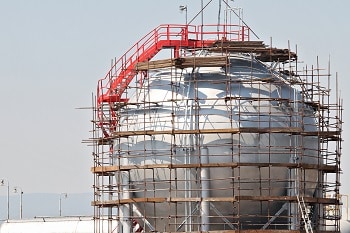Ideal Practices for Effective Tank Welding Inspection Processes
Ideal Practices for Effective Tank Welding Inspection Processes
Blog Article

Comprehending the Importance of Rigorous Storage Tank Welding Evaluation Processes in Averting Failures and Enhancing Life Expectancy
In the world of commercial procedures, the value of strenuous container welding examination procedures can not be overemphasized. By applying numerous examination techniques, companies can find problems early, consequently preventing expensive consequences and prolonging the life of their storage tanks.
Value of Welding Evaluations
Acknowledging the vital function of welding evaluations in maintaining architectural honesty, these processes guarantee that welds meet established criteria and specifications - Tank Welding Inspection. Effective welding examinations are extremely important in the building and construction and maintenance of tanks, as they straight affect the durability and safety of the frameworks. By determining potential shortages, such as incorrect techniques or product flaws, evaluations mitigate the threat of devastating failures
Welding assessments include numerous methods, including visual examinations, non-destructive testing (NDT), and assessments of welding procedures. Each approach offers to confirm the high quality and compliance of welds with sector policies, thereby securing both personnel and ecological interests. Routine inspections promote a society of responsibility and quality within the workforce, guaranteeing that all team participants stick to ideal methods.
Furthermore, these evaluations add to the overall lifecycle administration of tanks by identifying wear or destruction early while doing so. By addressing these problems proactively, companies can expand the functional lifespan of their possessions, eventually bring about cost savings and improved integrity. In recap, the significance of welding assessments can not be overemphasized; they are essential for guaranteeing security, long life, and conformity in container construction and maintenance.
Typical Sources Of Container Failings
Comprehending the typical root causes of storage tank failures is vital for stopping disastrous occurrences and ensuring the longevity of storage systems. One common root cause of tank failure is deterioration, which can dramatically damage the architectural stability of storage tanks in time. Environmental factors, such as direct exposure to dampness, chemicals, and temperature level changes, can increase this procedure.
Another crucial aspect is inappropriate welding methods, which may lead to issues like cracks or insufficient joints. These problems can jeopardize the container's toughness and lead to leaks or tears. Additionally, inadequate upkeep methods can result in unseen deterioration, ultimately raising the danger of failure.
Layout defects, including poor thickness or inadequate material selection, can likewise contribute to container vulnerabilities. Operational aspects, such as overfilling or exposure to severe stress, can strain the container beyond its desired limitations.
Trick Evaluation Strategies
Efficient inspection techniques play a vital function in minimizing the dangers connected with tank failings. A comprehensive technique to storage tank welding inspection includes numerous essential strategies, each designed to determine possible defects and guarantee architectural integrity.
Visual assessment continues to be the first line of protection, permitting inspectors to recognize surface area anomalies such as fractures, rust, or imbalance. This technique is typically supplemented by non-destructive screening (NDT) approaches, which are important for examining weld top quality without compromising the tank's stability.

Additionally, magnetic fragment screening (MPT) and dye penetrant testing (DPT) work for identifying surface area defects in ferromagnetic materials and non-porous surfaces, respectively. Each method has its toughness and constraints; consequently, a combination of methods is typically utilized to accomplish thorough browse around this site inspection results.
Benefits of Rigorous Evaluations
While the instant expenses of extensive evaluations may seem difficult, the long-lasting benefits considerably exceed these preliminary investments. Executing comprehensive evaluation processes not only boosts the honesty and safety and security of container frameworks however also minimizes the risk of tragic failings that can lead to considerable financial losses and ecological harm.
Extensive evaluations help identify possible problems early in the welding process, enabling prompt restorative actions that prevent pricey repair services or replacements down the line. This proactive strategy promotes a culture of quality guarantee, where adherence to finest practices comes to be instilled in operational procedures. Routine inspections add to enhanced property durability, as they ensure that tanks continue to be in optimal condition throughout their life-span.
Furthermore, the documentation generated from these inspections see post offers as a valuable source for maintenance preparation and efficiency assessments. This data-driven approach can likewise boost operational performance, resulting in lowered downtime and improved efficiency. Ultimately, extensive examinations not only secure the architectural stability of containers yet also supply significant economic advantages, enhancing the idea that buying high quality guarantee is a wise decision for any kind of company associated with storage tank procedures.
Governing Standards and Compliance
Regulative criteria and conformity are important elements of container welding examination processes, as they establish the framework for making sure safety and look at this now security and quality in operations. Compliance with these requirements not only alleviates threats but likewise improves the total honesty of bonded structures. Different companies, consisting of the American Culture of Mechanical Designers (ASME) and the American Oil Institute (API), give standards that determine appropriate practices for welding, inspection, and testing.
These standards mandate the use of qualified personnel, the implementation of rigorous evaluation procedures, and adherence to particular welding procedures. By lining up with regulative requirements, organizations can ensure that their storage tanks meet the required safety and performance requirements, consequently minimizing the probability of disastrous failures that can result in significant financial losses and ecological damages.

Moreover, regulative conformity promotes a culture of liability and continual improvement within the welding and construction fields (Tank Welding Inspection). Normal audits and examinations guarantee that techniques remain straightened with progressing criteria, therefore promoting long-lasting integrity and operational performance. Ultimately, adherence to regulative criteria not just secures assets however additionally boosts the life-span of welded tanks, guaranteeing they serve their intended function successfully with time
Final Thought
In conclusion, strenuous tank welding inspection processes play an essential duty in stopping failings and prolonging the life-span of storage structures. By identifying potential shortages via numerous inspection methods, companies can minimize dangers associated with tank honesty.
Report this page